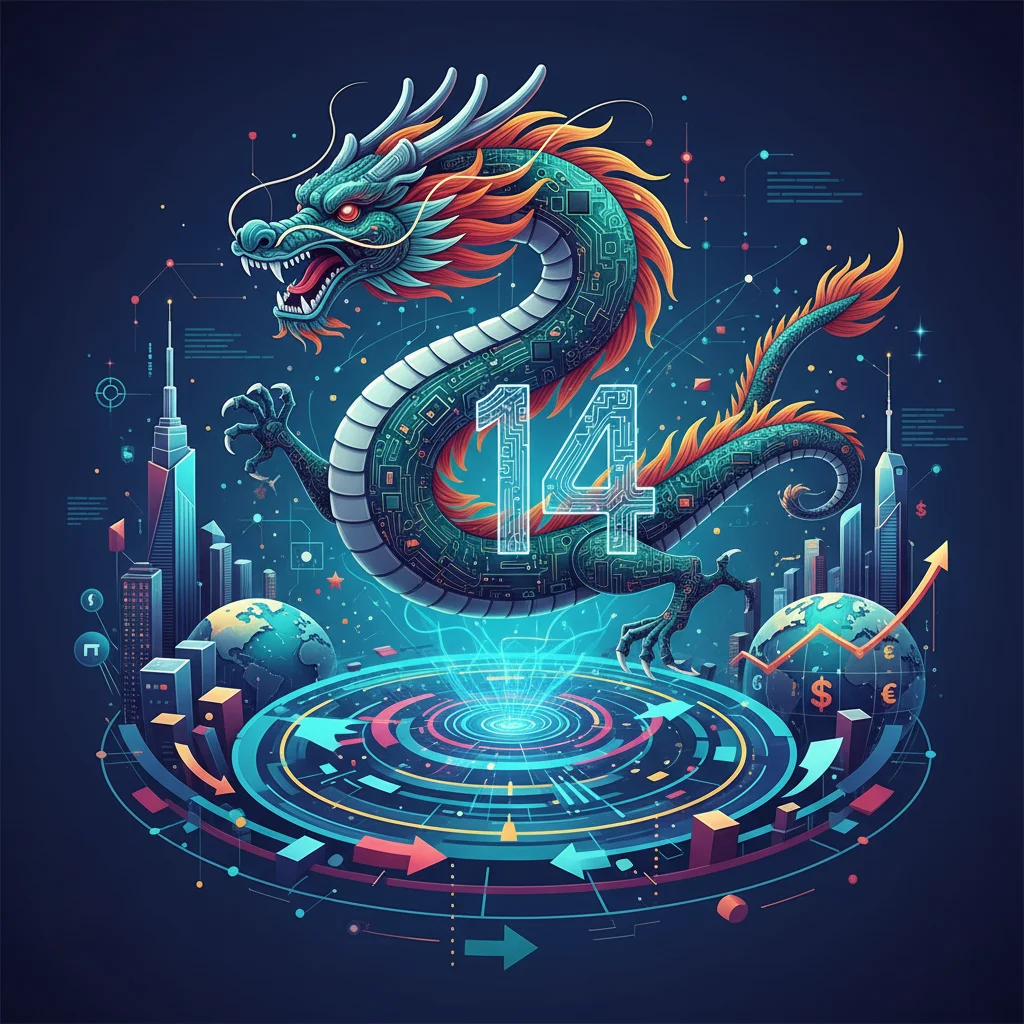
China’s High-Tech Gambit: Decoding the New 5-Year Plan for a Global Economy in Flux
The Dragon’s New Blueprint: Navigating China’s Economic Overhaul
The world of global finance and investing is holding its breath. As Beijing prepares to unveil its next five-year economic plan, the signals are clear: China is embarking on one of its most significant strategic pivots in decades. Faced with a potent cocktail of escalating tech tensions with the United States and persistent domestic economic headwinds, the nation is doubling down on a future powered by high-tech self-reliance and robust internal consumption. This isn’t just another policy update; it’s a fundamental rewiring of the world’s second-largest economy, with profound implications for the global stock market, international supply chains, and the future of financial technology.
The upcoming third plenum, a crucial meeting of the Communist Party’s Central Committee, is set to formalize this ambitious agenda. The core theme revolves around developing what President Xi Jinping calls “new productive forces.” This isn’t about building more of the same; it’s a strategic mandate to leapfrog into next-generation industries, from artificial intelligence and quantum computing to biotechnology. Simultaneously, leaders are acutely aware of the deflationary pressures threatening the economy, making the stimulation of domestic consumption not just a goal, but a necessity for survival. For investors, business leaders, and finance professionals, understanding the nuances of this plan is critical to navigating the complex opportunities and risks that lie ahead.
A Strategy Forged in Fire: The Twin Pressures on Beijing
China’s strategic shift is not happening in a vacuum. It is a direct response to two powerful and converging forces: intense external pressure and mounting internal challenges.
The External Catalyst: The US-China Tech War
The primary driver behind the aggressive push for technological self-sufficiency is the ongoing and intensifying strategic competition with the United States. Washington has implemented a series of stringent export controls and sanctions aimed at crippling China’s access to critical technologies, particularly advanced semiconductors. High-profile actions against companies like Huawei have served as a stark wake-up call for Beijing, demonstrating the vulnerability of its tech sector to foreign policy decisions. This has transformed the goal of technological independence from a long-term ambition into an urgent matter of national security and economic sovereignty. China is determined to break its reliance on Western technology, creating its own domestic ecosystem for everything from chip design and manufacturing to advanced software and AI models.
The Internal Imperative: A Stuttering Economic Engine
While the tech war rages externally, China’s domestic economy is flashing several warning signs. The post-pandemic recovery has been weaker than anticipated, hampered by a deep crisis in the property sector, soaring local government debt, and worryingly low consumer confidence. The nation is grappling with the real threat of deflation—a vicious cycle of falling prices that can stifle growth, depress wages, and paralyze investment. The old growth model, reliant on real estate and infrastructure investment, has clearly run its course. The Central Committee is expected to highlight the critical importance of boosting domestic consumption as a new, more sustainable engine for growth (source). This dual-track approach—fostering high-tech industries to create wealth and encouraging citizens to spend it—forms the very foundation of the new economic blueprint.
The .2 Trillion Typo: Unpacking the Monumental Foreign Investment Bet on America
Decoding the “New Productive Forces”
At the heart of China’s new strategy is the concept of “new productive forces.” This term signifies a departure from traditional, resource-intensive manufacturing towards an innovation-driven model focused on high-tech, high-efficiency, and high-quality development. It’s a national mobilization of resources—capital, talent, and policy support—into specific sectors deemed critical for future global competitiveness. The government is signaling to the market where the future of Chinese investing lies.
Below is a breakdown of the key sectors that form the pillars of this ambitious vision:
| Priority Sector | Strategic Importance | Key Focus Areas & Initiatives |
|---|---|---|
| Semiconductors | The “choke point” of modern technology. Reducing reliance on foreign chips is a top national security priority. | Massive state investment in domestic foundries (e.g., SMIC), chip design software (EDA), and advanced packaging. |
| Artificial Intelligence (AI) | Seen as the key to future productivity gains across all industries, from manufacturing to finance. | Development of large language models (LLMs), AI applications in autonomous driving, smart cities, and industrial automation. |
| Biotechnology & Pharma | Aims to move up the value chain from generic drugs to innovative new treatments and medical devices. | Gene editing, mRNA vaccine technology, and advanced biomanufacturing. |
| Green Technology | Leveraging China’s dominance in solar panels, batteries, and electric vehicles to lead the global energy transition. | Next-generation battery technology, hydrogen power, and smart grid infrastructure. |
| Financial Technology (Fintech) | Enhancing the efficiency of the domestic banking and financial system to better allocate capital to new industries. | Expansion of the digital yuan (e-CNY), use of blockchain for secure trading, and AI-driven credit scoring. |
The Consumption Conundrum: Can 1.4 Billion People Spend Their Way to Prosperity?
Developing cutting-edge technology is only half the battle. For the strategy to succeed, China must solve its long-standing consumption puzzle. The theory is sound: high-tech industries create high-value jobs, which should lead to higher incomes and, consequently, more consumer spending. However, translating this theory into reality is fraught with challenges.
Chinese households are notoriously high savers, a habit born from an inadequate social safety net. Concerns about healthcare costs, education expenses, and retirement security compel people to save rather than spend. Furthermore, the recent property market collapse has wiped out a significant portion of household wealth, severely denting consumer confidence. The government’s challenge is not just to encourage spending but to create the structural conditions—like stronger social welfare and a stable job market—that make consumers feel secure enough to open their wallets. Measures to watch for will include potential consumer subsidies, reforms to the pension system, and efforts to stabilize the volatile stock market to restore investor and consumer faith. According to analysts cited by the Financial Times, the success of this plan hinges on whether Beijing can effectively rebalance the economy toward consumption (source).
Beyond the Bourse: Why Marseille's Luxury Real Estate is the Ultimate Alternative Investment
Investment Playbook: Navigating a Policy-Driven Market
For global investors and corporations, China’s new plan redraws the map of opportunities and risks. The era of easy growth by simply tapping into a rising middle class is over. The future lies in aligning with Beijing’s strategic priorities.
- Opportunities for Investors: The clearest opportunities are in the “new productive forces” sectors. ETFs and funds focused on China’s semiconductor, AI, EV, and green energy industries are likely to see significant policy support. The fintech space, especially companies involved in digital payments and blockchain infrastructure, also stands to benefit as China builds a more robust internal financial system. However, this is a policy-driven market, meaning investing requires a keen understanding of political winds.
- Risks and Volatility: The Chinese stock market remains susceptible to sudden regulatory crackdowns and geopolitical flare-ups. The push for self-reliance could also lead to increased protectionism, making it harder for foreign firms to compete. Due diligence and a high tolerance for volatility are prerequisites for any investment in this space.
- Implications for Global Business: Companies that supply critical technology to China may face diminishing market share as domestic alternatives are nurtured. Conversely, businesses that can contribute to China’s high-tech goals—without crossing Western sanctions—may find new opportunities. The key takeaway for business leaders is the urgent need to de-risk supply chains and reassess their “China-plus-one” strategies.
The Gulliver Effect: How a Thousand Legal Threads Could Tie Down the US Economy
Conclusion: A High-Stakes Bet on the Future
China’s forthcoming five-year plan is more than an economic document; it’s a declaration of intent. It is a bold, high-stakes response to a world it views as increasingly hostile and a domestic economy in need of a new engine. The dual-pronged strategy of pursuing technological supremacy while simultaneously building a resilient, consumption-driven domestic market is breathtaking in its ambition. Its success is far from guaranteed and will depend on Beijing’s ability to foster genuine innovation and overcome deep-seated structural imbalances.
For the rest of the world, this plan signals an acceleration of the great power competition and a further fragmentation of the global economy. Whether you are in finance, technology, or manufacturing, the shockwaves from this strategic shift will be felt for years to come. The dragon is charting a new course, and the world must be prepared to navigate the turbulent waters ahead.


